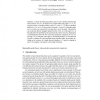Free Online Productivity Tools
i2Speak
i2Symbol
i2OCR
iTex2Img
iWeb2Print
iWeb2Shot
i2Type
iPdf2Split
iPdf2Merge
i2Bopomofo
i2Arabic
i2Style
i2Image
i2PDF
iLatex2Rtf
Sci2ools
IWPEC
2004
Springer
2004
Springer
Chordless Paths Through Three Vertices
Consider the following problem, that we call “Chordless Path through Three Vertices” or CP3V, for short: Given a simple undirected graph G = (V, E), a positive integer k, and three distinct vertices s, t, and v ∈ V , is there a chordless path from s via v to t in G that consists of at most k vertices? In a chordless path, no two vertices are connected by an edge that is not in the path. Alternatively, one could say that the subgraph induced by the vertex set of the path in G is the path itself. The problem has been raised in the context of service deployment in communication networks. We resolve the parametric complexity of CP3V by proving it W[1]-complete with respect to its natural parameter k. Our reduction extends to a number of related problems about chordless paths. In particular, deciding on the existence of a single directed chordless (s, t)-path in a digraph is also W[1]-complete with respect to the length of the path.
| Added | 02 Jul 2010 |
| Updated | 02 Jul 2010 |
| Type | Conference |
| Year | 2004 |
| Where | IWPEC |
| Authors | Robert Haas, Michael Hoffmann |
Comments (0)

